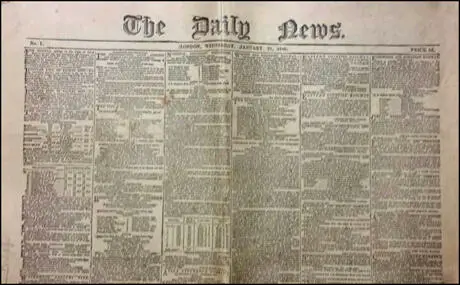The Daily News
Charles Dickens was a supporter of the Liberal Party and in 1845 he began to consider the idea of publishing a daily newspaper that could compete with The Times. He contacted Joseph Paxton, who had recently become very wealthy as a result of his railway investments. Paxton agreed to invest £25,000 and Dickens' publishers, Bradley & Evans, contributed £22,500. Dickens agreed to become editor on a salary of £2,000 a year.
The first edition of The Daily News, published on 21st January 1846. Dickens wrote: "The principles advocated in the Daily News will be principles of progress and improvement; of education, civil and religious liberty, and equal legislation." Dickens employed his great friend and fellow social reformer, Douglas Jerrold, as the newspaper's sub-editor. Dickens put his father, John Dickens, in charge of the reporters. He also paid his father-in-law, George Hogarth, five guineas a week to write on music.

William Macready wrote in his diary that John Forster told him that The Daily News would greatly injure Dickens: "Dickens was so intensely fixed on his own opinions and in his admiration of his own works (who could have believed it?) that he, Forster, was useless to him as a counsel, or for an opinion on anything touching upon them, and that, as he refused to see criticisms on himself, this partial passion would grow upon him, till it became an incurable evil."
One of the newspaper's first campaigns was against the Corn Laws, that had been introduced by the Conservative Party government. When Robert Peel, the Prime Minister, told the House of Commons that he had changed his mind about the legislation, Dickens did not believe him and wrote in the editorial that he was "decidedly playing false".
The Times had a circulation of 25,000 copies and sold for sevenpence, whereas The Daily News, provided eight pages for fivepence. At first it sold 10,000 copies but soon fell to less than 4,000. Dickens told his friends that he missed writing novels and after seventeen issues he handed it over to his close friend, John Forster. The new editor had more experience of journalism and under his leadership sales increased. John Wentworth Dilke, the former editor of The Athenaeum also joined the paper. Over the years many of the leading writers with Liberal opinions contributed to the newspaper, including figures such as Charles Mackay, Harriet Martineau, George Bernard Shaw, Henry Massingham and H. G. Wells.
In 1901 the Daily News was purchased by George Cadbury, the Quaker owner of Cadbury Brothers and a strong supporter of William Gladstone and the Liberal Party . Cadbury used the newspaper to campaign for old age pensions and against sweated labour. As a pacifist, Cadbury and the newspaper were opposed to the Boer War.
The Daily News was absorbed by the Daily Chronicle in 1930 became the News Chronicle. It continued publishing under this name until it closed in 1960.

